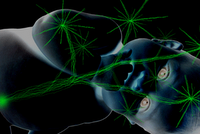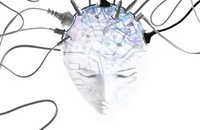
Since the publication of this
article on the intelligence of dolphins, over 200 blogs and news outlets have covered the paper's highly controversial thesis: dolphins may not be as smart as we think they are. Before offering my opinion on the article, I thought I'd summarize the article itself and what's already been said about it in the cognitive blogosphere.
Briefly, Paul Manger's (quite technically impressive) Biological Reviews article states that:
1) Behavioral experiments that purport to demonstrate dolphin intelligence are often poorly controlled, difficult to replicate, and disputed by other scholars; therefore, this evidence is not considered in any detail;
2) Some of the most computationally important anatomical characteristics of the primate brain (such as the hippocampal formation) are extremely underdeveloped, while yet others (such as Layer IV in neocortex, and prefrontal cortex
in toto) seem to be
completely missing in dolphin brains;
3) Naive indices of dolphin brain size/complexity (such as encephalization indices) suggest that dolphin brains are as complex as some primate brains, but more sophisticated analyses (such as corticalisation indices) suggest that dolphin brain size is primarily an adaptation to living in cold water;
4) Viewing dolphin brain function as an adaptation to living in cold water is powerfully explanatory and explains
many confusing differences between dolphin and primate brains (such as the altered glial:neuron ratio, consistently higher noradrenaline levels, vastly different sleep patterns, relatively undifferentiated neuronal morphology, and the homogenous scaling of body:brain mass among cetaceans in contrast with the heterogenous scaling seen among primates);
5) Evolutionary increases in dolphin brain size were extremely abrupt, and coincide well with an estimated dip in ocean water temperature roughly 20 million years ago. This is taken as evidence that brain size change was a result of selection pressure for increased thermogenesis.
It apears the discussion in the blogosphere was ignited by
this technically inaccurate and otherwise poor article at the Sun-Times and subsequent coverage on
Slashdot. Now, for what the cognitive blogosphere has to say about the idea that dolphins are "dumber than goldfish," as the popular press coverage often claimed:
What, Doesn't Intelligent Behavior Count? (
Majikthise, August 23)
Philosopher Lindsay Beyerstein suggests that this study should be taken with a grain of salt, given that a multitude of studies show dolphins can behave intelligently (such as maintaining "complex and dynamic" social relations, being trained for mine-sweeping, self-recognition, and spontaneous imaginative play).
Commenter
Michael points out that dolphins have also been known to
gossip, which to him makes them "at least as intelligent as bloggers."
Maybe Dolphins Aren't Smart After All. (
Cognitive Daily, August 21)
Dave Munger admits that while the argument against dolphin intelligence may be somewhat simplistic, the evidence for dolphin intelligence is ambiguous at best. He concludes that while "dolphins may be cute, and they can be trained to do impressive tricks, [...] it's doubtful that they possess humanlike intelligence."
Commenter Dwight Brown suggests that all our definitions of intelligence are anthropocentric, by necessity: from an evolutionary point of view, intelligence is reflected in species-specific adaptations to that species' environment. He suggests that we "check back in a couple of million years and see who is the most intelligent at that point!"
Commenter
RixiM MixiR points out that neuroanatomical differences in dolphin brains could reflect differences in perceptual abilities rather than in intelligence, and reminds us how much of the human brain is devoted to perceptual processing.
Irrational and Anthropocentric Hogwash! Dolphins are smart. (
A Blog Around the Clock, August 28)
Coturnix insists intelligence is so obvious in dolphins' behavior that we've known they were intelligent for millenia. Coturnix ridicules Manger's unfortunate comment in a press interview about serotoninc as a "happy drug," and notes that thermogenesis is not an established function of glial cells. Given the number of publications that have established "intelligent" behavior in dolphins, why would Manger write this paper? Coturnix argues the answer is our anthropocentric defintion of intelligence, and that a better definition would involve "behavioral flexibility."
Careful How You (Re)Define Intelligence... (
Cognitive Daily, August 28)
Dave Munger agrees on the difficulty in defining intelligence but insists that an anthropocentric definition is most productive, assuming that "the point is to identify animals that are similar to ourselves."
Faster, Harder and Stronger ... With Regard to What? (
addendum to previous Blog Around the Clock post, August 28)
Coturnix asks what criteria should be used for identifying animals similar to ourselves, and suggests that if intelligence is "provisionally defined as fast learning, high processing power and flexibility of behavior, then we can compare species without looking at specific items that are learned, specific information that is processed and specific behaviors that are flexible."
Neural Data is Better than Behavioral Data (
Abstract Nonsense, August 29)
Alon Levy argues that "brain data" is "harder to misinterpret than behavioral data," and existing behavioral data may overestimate the intelligence of dolphins on the basis of inappropriate anthropocentrism: "Dolphins communicate more-or-less verbally; hence they’re intelligent. Dolphins use tools; hence they’re intelligent. Dolphins are smart hunters; hence they’re intelligent."
Glia are Information Processors, So Try Again (
Adam Bastard, September 1)
Adam points to the emerging view that glial cells are important for information processing, and correctly identifies this as a fatal flaw in Manger's argument: "With this information, it seems ridiculous to conclude that intelligence is negatively related to the volume of glia. That's a major blow to the theory of dolphin stupidity."
A Biased Synthesis: My Conclusions
1) Identifying the neuroanatomical correlates of cognition is still a highly theoretical discipline, and has been carried out largely in humans. The idea that we can confidently extrapolate in the opposite direction - from neuroanatomy to cognition - is almost completely untenable.
2) The above is even more true in cases where the neuroanatomy differs so profoundly from that on which the majority of cognitive neuroscience is based, which is a point underscored by Manger's detailed comparisons of cetacean and human neuroanatomy.
3) Brains are the most metabolically expensive organ in the body, so it seems like a maladaptive solution to natural selection for body temperature regulation (particularly given the prevalence of convergent evolution in mammal phylogeny, and that the solution almost all other cold climate mammals have adopted is blubber);
4) Until you show that human neuroanatomy is the only system that can lead to human-level intelligence, differences in dolphin neuroanatomy are irrelevant;
5) Even if dolphin brain size increased in response to selection pressure for thermogenesis, this increase in size might become an exaptation and nonetheless translate into improved information processing (a possibility highlighted by neuroscience's increasing appreciation for the computational importance of glia).
In conclusion, there are countless reasons to doubt that dolphins are "dumber than goldfish," or indeed that popular musings about dolphin intelligence have been inaccurate. Of course, as Cognitive Daily points out, it is clear that they don't have human-level intelligence - whatever that may mean. On the other hand, Manger has developed a new theory about the evolution of the dolphin brain; unfortunately, any extrapolation from neuroanatomy to cognition is still highly theoretical, particularly in the case of dolphins, whose brains are so drastically different from our own. Therefore, given the state of neuroscience, judgments of dolphin intellectual powers must more heavily weigh behavioral work (however flawed) than arguments from evolutionary data and cellular neuroscience such as Manger's.
 One topic of increasing popular interest is "brain fitness," or how to maintain and further develop cognitive abilities. One need not look farther than the current sudoku craze to see that people everywhere are eager to keep themselves mentally engaged. But to what extent can the outlets for this urge be informed by the cognitive and neural sciences?
One topic of increasing popular interest is "brain fitness," or how to maintain and further develop cognitive abilities. One need not look farther than the current sudoku craze to see that people everywhere are eager to keep themselves mentally engaged. But to what extent can the outlets for this urge be informed by the cognitive and neural sciences?












